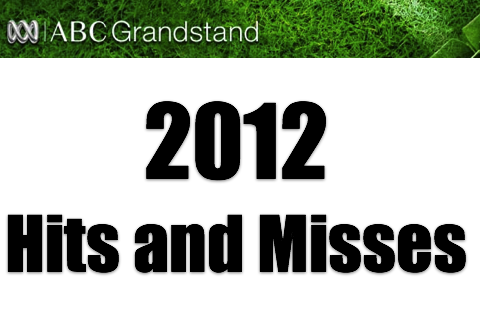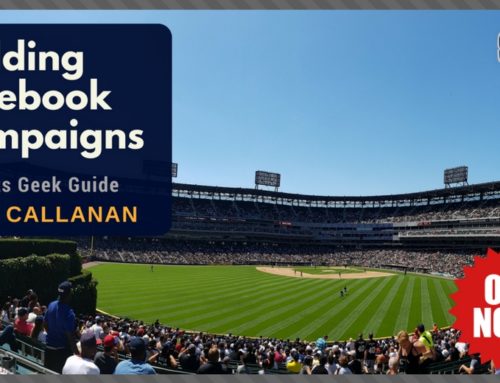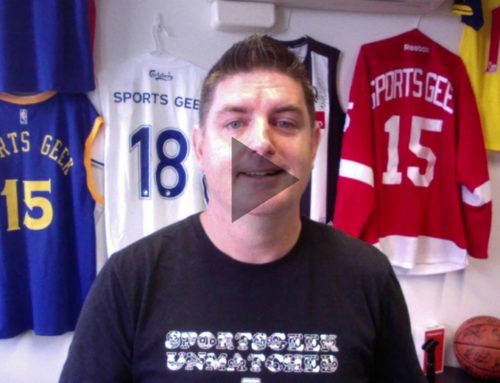The last ABC Grandstand segment for 2012 was a wrap of the hits and misses in the sports social world from all the big sporting events. Francis and I discussed the biggest moments, hits and misses from around the globe.
Hits
London Olympics
Of course, Jamaican sprinter Usain Bolt’s 100m and 200m races were the peak of traffic on social media from the Social Olympics, and as a point of interest, Foxtel’s 8 channels offered great coverage.
Euro 2012
The European Championships in 2012 smashed Twitter records, showing the global nature of both football and Twitter. The apex of tweeting for Euro 2012 was with Spain's fourth and final goal in the final against Italy, which generated more than 15,000 tweets per second worldwide.
NRL’s new digital deal
The new NRL Digital deal is quite groundbreaking in Australia. It’s not carrier specific so everyone can see it, so it makes watching NRL easier and is a win for both Telstra and the NRL.
NASCAR’s Brad Keselowski tweeting during a race.
He was stationary at the time, but NASCAR driver Brad Keselowski tweeted a picture from the racetrack. It gave fans a great insight and a view of the race from the athlete's perspective.
Fire!My view twitter.com/keselowski/sta…
— Brad Keselowski (@keselowski) February 28, 2012
Misses
Instagram v Twitter
The Instagram v Twitter dispute has been happening for a while. Twitter didn’t allow Instagram to use Twitter to find friends and then Instagram have stopped showing Instagram pics in Twitter natively via Twitter cards meaning traffic goes to their site. There’s also been some trouble about Instagram’s new privacy guidelines.
TJ Lang’s anti-replacement ref tirade
We can’t post it here because it was profanity laced, but Green Bay Packers guard TJ Lang was quite upset with the NFL when it’s replacement refs blew a call that cost them an early season win against the Seattle Seahawks.
Blaming social media
The Australian Swimming Team came under fire for their poor performance in the pool at the London Olympics, prompting a few to blame social media as the distraction that stopped them performing their best.
Athletes buying followers
There were a few athletes in 2012 who bought Twitter followers to boost their numbers. In the end, it does nothing for their personal brand and, as Wil Anderson said at #TwitterBrekky, “It’s like putting a sock down your pants”.
Until next time
Sean’s segment is on a break at the moment put check back for more segments throughout 2013. You can follow Francis Leach and ABC Grandstand on Twitter.
Want to get these clips in podcast form? Subscribe here or Add to iTunes.
Podcast transcription
Francis: Good morning Sean Callanan from Sports Geek HQ, welcome back to the studio, how are you?
Sean: I’m good thanks, fired up for a big day of Christmas shopping, get it all done in one day.
Francis: Well you can do it online! I’m surprised you’re actually going to bricks and mortar retail.
Sean: Yeah, I actually still prefer to see it, I do a bit online but I prefer to actually see it and be inspired by what I see.
Francis: Check what everybody else is…
Sean: Got to support the bricks and mortar retail.
Francis: You do and I was doing it yesterday. Good luck with that! Sean has been with us all year talking about sports in the digital space and today we’re doing Hits and Misses of 2012 and so much has happened over the year. And some big events too, like in all sectors of life, big events or big challenges often bring breakthroughs and solutions and the London Olympics for digital sports media coverage was a real watershed moment wasn’t it?
Sean: Oh definitely. Even from some of the small things from the fan’s point of view, not really talking about the things that happened in the pool and on the pitch and on the track. The fact that the fans at the stadium were able to tweet and send Instagrams and tell people what the event was like. So getting stuff like the Wi-Fi coverage, when you talk about it was going so well that it was affecting the TV coverage. So it was great for the people at the event to be able to share the event.
Francis: So what were they doing differently to say some of our big sporting stadiums here in Australia that really struggle with capacity?
Sean: They definitely put a lot of money into the infrastructure to be able to support it. As we’ve spoken about with really tech savvy stadiums like AT&T Park in the San Francisco Giants in the major league baseball, it can be done. It just needs to have one, the right tech partners involved and from a ‘how do we pay for it' point of view, making sure those partners get credit in bringing it. So they would have had to put in a lot of technical infrastructure, especially around the Olympic stadium and probably do some extra things around some of the venues to make sure people can use it. But it really made for a great experience because we got a lot of great content, even just from athletes. There was a little bit of common sense around the social media policy.
Francis: Because the Olympics have a fairly hard line when it comes to all sorts of content that has Olympic ground ramifications. You can’t even show seven seconds or more of an Olympic event if you’re not a rights holder and they are militant in enforcing that. And they were going to try that with social media weren’t they?
Sean: They were.
Francis: They threatened it.
Sean: They threatened it. And to a large degree everyone knows their forms and to adhere to it. Video was still a bit no-no, no one was allowed to be shooting any kind of video but they definitely loosened the rules a little bit. And just by the volume it would have been too hard for them to follow up and say “you can’t be tweeting”, that kind of thing. So it did provide a highlight on the track, we had Usain Bolt, he’s 100 and 200 being the peak of traffic on Twitter.
Francis: What sort of numbers do you remember was he trafficking?
Sean: It wasn’t as big as it could have been because I was in the US at the time with the delay.
Francis: Oh the delay!
Sean: The delay of coverage. So it wasn’t as big as it could have been. I think from my brown slides a couple of weeks ago at the Twitter Brekkie, I think it’s the third biggest Twitter event, still behind Euro 2012. So Twitter is still really a global game, so Euro 2012 was the biggest Twitter event from a tweets-per-second point of view. But also the other part of the digital side of it was just the coverage we got from a TV perspective.
Francis: It revolutionised television coverage, the Foxtel coverage of the Olympic games.
Sean: Yeah, so being able to watch the eight, or keep track of the eight channels via your iPad and the TV was this two screen experience. We had a lot of people talk about it and they sort of talk about the Twitter and Facebook as our second screen but with Foxtel we actually had that two screen and frankly a third screen, because you were watching one channel there keeping an eye on the hockey or swimming races coming up and you had that third device following Twitter and seeing what it was doing. So it definitely shows what they’re capable of. It will just be interesting to see if that gets applied to smaller sports, the new NRL deal that they’ve done. Expect to see something similar to that by the guy at Fox Sports and Foxtel and NRL because they pay a lot of money and they really want to make sure that they deliver to fans.
Francis: And they’re delivering sport live to mobile platforms in full, so that’s an interesting way to do it.
Sean: In full. And what’s really groundbreaking from a sport’s point of view, they’re not tied to a particular mobile carrier. So everybody will be able to see it and that’s a really big leap and I think it’s a great move for Telstra who have bought the rights. You’re going to go and use all your data; it will be a good way to draw people across to their networks. And it’s great for the NRL because it just grows the game for them.
Francis: And Nascar has been a bit of an innovated issue when it comes to digital sports media isn’t it?
Sean: Well it has, we’re lucky enough to have Brad Keselowski tweet during a race. Now, occasionally…
Francis: You could get arrested by the cops doing that!
Sean: Tweet only at the lights! But yeah, there was actually a car crash and why a race car driver had his iPhone, I don’t even know where there’s a pocket, did he have a specific pouch? He probably has a sponsor patch on it somewhere but he pulled out his iPhone, took a picture of the crash in front of him and tweeted it and it obviously went viral. It was really an opportune time, Twitter had just done their first TV ad with Nascar and they had a specific Nascar page on Twitter so it was really good for them.
Francis: How long before we see Buddy Franklin or Sonny Bill Williams pull an iPhone or pull a device out of their sock after they score a goal or a try and just take a photo of the crowd and just tweet that.
Sean: Unfortunately I think the time has passed. I think social media policies don’t allow that, they could schedule a tweet that goes halfway through the game but they will get in trouble and we would like to see a little bit of fun with that but I don’t think we’ll see that anymore.
Francis: Damn! We’re with Sean Callanan from Sports Geek HQ talking about sport and the digital media in 2012, that’s the good stuff. Some people have missed the boat though.
Sean: A little bit. Instagram and Twitter have been a little bit backwards and forwards fight ever since Instagram was bought by Facebook. So they’re always competitors but now.Francis: The gloves are off!
Sean: Now the gloves are off, it’s a bit like someone moved from Carlton to Collingwood kind of thing, it just spices it up a little bit more and so they’ve been having a bit of a fight. Twitter didn’t allow Instagram to find friends and then just in the last couple of weeks Instagram have stopped showing Instagram pictures in your Twitter feed natively via the Twitter cards. Which doesn’t seem too much but…
Francis: It’s a statement of intent.
Sean: It is, they want the traffic to go to their site and to their app which is quite valid, that’s what they want to do but it does make for a poor Twitter experience if you’re seeing a picture and you have to click on a link and go out of Twitter. It will have a detrimental effect on the growth from a Twitter point of view. And then we had Instagram release the new terms of service, or at least try to where they were saying they’re your photos but we’ve got rights to them forever and if we want to use them in ads we will. They’ve done a little bit of back pedalling.
Francis: Because the reaction was fierce from a lot of people.
Sean: There was a Richmond Football Club, ‘I’m going to microwave my phone’ type of response that they might do after a bad loss. So yeah there was people saying ‘I’m going to delete my Instagram account, how dare you take pictures of my poached eggs and use them in an ad’. So it was a bit irrational.
Francis: Yeah the cover of Vogue, suddenly your fried eggs will be on the cover of Vogue and you’ll get nothing for it!
Sean: Yeah exactly. There will be pictures of your legs while you’re sitting at a beach. So I think common sense will prevail. Instagram have to make money, they’ve been bought by Facebook but the idea is they’re going to be an ongoing business. So there will be some advertising in there. Mostly it will be around the data around what you’re doing. So what you’re liking and why you’re liking and there will be some way for them to embed content in there. So that will be something that will be interesting for the next year.
Francis: Sean, because Twitter is and social media is publishing and inevitably in publishing someone is going to get themselves in trouble by saying something they shouldn’t have, who won the price for the biggest ‘oops’ of the year?
Sean: I think TJ Lang of the Green Bay packers. Earlier on in the season the NFL had the replacement refs on Monday night football, they made a little bit of a mistake, put my disclaimer there, I’m a Green Bay packers fan, I tend to agree with TJ. It was an end of game play and cost Green Bay the game and TJ decided to go on Twitter and drop the F bomb, said ‘F the NFL, get rid of the refs, if you fine me give it to the proper refs’, is pretty much what he said in a couple of tweets.Francis: And they did fine him, how much?
Sean: They fined him, I think it was, it was over a hundred grand, it was a fair chunk of change but he did get 90,000 re-tweets for his message. So he got a bit notoriety and funnily enough, the refs, it got a bit more coverage for the NFL refs who were getting a lot of support on Twitter and a couple of weeks later they were back at work so maybe put that down to the power of social media and he might get a few Christmas cards from some NFL refs that got a bigger pay payment thanks to TJ Lang.
Francis: And closer to home probably the sports organisational body that missed the boat with social media this year or got it wrong?
Sean: I guess the main thing going back to the Olympics was the Australian swimmers.
Francis: Blaming Facebook for being too late at night.
Sean: And blaming Twitter and reading a bit too much of their own mentions and getting caught up in their own mentions feed a little bit and they really just didn’t have the people in place to say ‘Hey guys you don’t sit there scouring every single newspaper and listening to every single radio about how you’re going’, and it just crept into the village. So it was great from the fans point of view to be able to connect and say congratulations and good work. But when they were just falling short or when they did well early it did affect their preparation later on. It was a good experience for the Olympic team to understand that and it’s another part of preparation that athletes have to do going forward.
Francis: And I guess the other one in that sphere is be careful who follows you and don’t try to buy them. We had the incidents of athletes this year of basically having an auction of followers on Twitter in an unseemly battle of egos.
Sean: And again that’s the disappointing thing of buying Twitter followers, because athletes don’t need to and it’s a bit of an ugly part of Twitter. It’s not Twitter’s fault. There’s people offering these services that create these dummy accounts and inflate your numbers and I think Will Anderson put it best at the Twitter Brekkie said “Buying Twitter followers is like putting a footy sock down your shorts”. I won’t go through the rest of the joke because you’ve probably figured it out, but it is just a bit of false bravado. There’s a few out there and there’s other people that do it but it’s much better if it’s a genuine connection and you have a bit of backwards and forwards. It doesn’t matter what you tweet, Shane Warne, you might not agree with what he tweets but every now and then he does make a bit of sense on Twitter. I think just a couple of weeks go he said ‘If you don’t like what I’m tweeting, unfollow me’. And that’s a great philosophy. A lot of people do because they don’t want their bon-bon jokes spoiled because of the amount of bad jokes that Warne does on Twitter, but the other thing is he does provide a little bit of, like we see on the coverage of the big bash, every now and again he offers a little bit of insight that he proves he wouldn’t have got.
Francis: And that’s what it’s there for. Good on you Sean, thanks for coming in again today and have a fantastic Christmas and New Year and we’ll see you in 2013.
Sean: We will thank you very much.
Francis: Sean Callanan, you can find him at Sports Geek HQ or follow @SeanCallanan on Twitter and keep up to date with the latest in social media.





